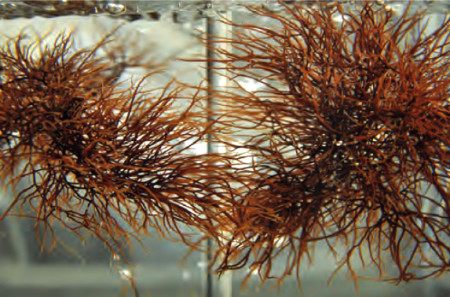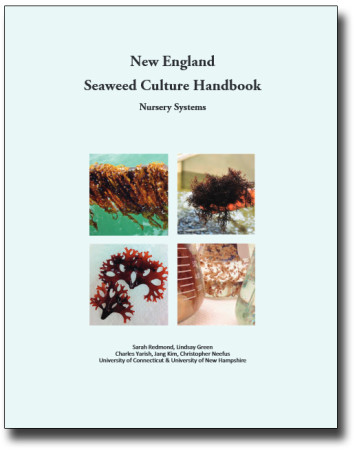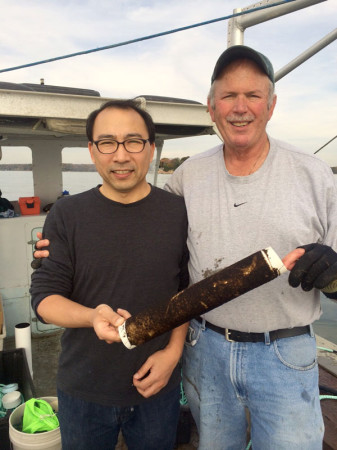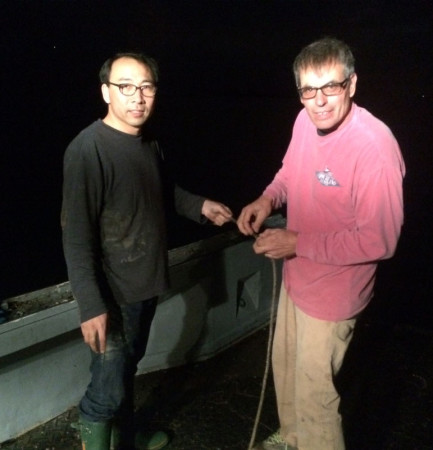
If you’re planning to make blancmange—a traditional milk pudding thickened with Irish moss seaweed—don’t forget a splash of brandy, says Dr. Charles Yarish, professor of ecology and evolutionary biology at the University of Connecticut (UConn). “The French always add a little brandy.”
Dr. Yarish is also a fan of Gracilaria or “ogonori,” a hairy sea vegetable that he farms in Connecticut’s coastal waters. He grows the native species, Gracilaria tikvahiae, though there is also a non-native Gracilaria that’s made its home on the U.S. east coast in recent years. Both species are edible, but the only way to tell them apart is a DNA fingerprint.
Seaweed for Healthy Waters
Yarish is a lover of seaweeds, not only for the dinner plate, but for the role they play in coastal ecosystems. His research dates back to the 1980’s and involves growing various species in his lab and at field sites off the coast.
One site is at the confluence of the Bronx and East Rivers in New York City, where his kelp farm helps to remove nitrogen and other excess nutrients caused by agricultural run-off, over-fertilized lawns, and even air pollution. A certain amount of nutrients in the water is a good thing, but too much can tip the balance, upsetting coastal ecosystems and causing die-offs of plants and animals, or unwelcome algal blooms like “red tide,” which render shellfish toxic for human consumption. “If we can use aquaculture systems to manage these nutrients, this is an exciting breakthrough,” Yarish said. “And we’ve shown we can do that.”
While his goal is ecosystem services, Yarish believes economic value is what will drive seaweed farming, which he sees as a solution to improving the health of coastal waters. In the case of the Bronx site, the kelp is unfit for human consumption. “We’ve tested the product to try to understand what we can do with it,” he said. Both biofuel and fertilizers prove to be promising solutions.
But seaweed grown in clean waters is another story. Aquaculture systems still benefit; and the seaweed can be harvested and eaten. Although the industry is in its infancy in the northeastern United States, nearly 16 million tons of seaweed were farmed worldwide in 2008, primarily in Asia, according to a United Nations report.
 Yarish has been helping to lay the groundwork for operations in the northeast. In 2006, he helped Ocean Approved start the first open-water kelp farm in the United States off the coast of Maine. After the Fukushima Daiichi nuclear disaster in Japan, which compromised the kelp (kombu) industry in Hokkaido, Ocean Approved started receiving requests to ship their product to Asia, he said.
Yarish has been helping to lay the groundwork for operations in the northeast. In 2006, he helped Ocean Approved start the first open-water kelp farm in the United States off the coast of Maine. After the Fukushima Daiichi nuclear disaster in Japan, which compromised the kelp (kombu) industry in Hokkaido, Ocean Approved started receiving requests to ship their product to Asia, he said.
Since then he has since turned his sights to Long Island Sound, where he’s been helping shellfish farmer Bren Smith of Thimble Island Oyster Company grow seaweed off Branford’s Thimble Islands. “Thimble Island is producing healthy, high quality, high value product that can go for human food consumption,” Yarish said. “You can have a nice, nitrogen-rich vegetable that takes in nitrogen available to it in coastal waters.”
Seaweed products from Long Island Sound and the Gulf of Maine have met FDA guidelines, and even made France’s stringent guidelines. “Plus they taste good, which is more important,” Yarish said.
In 2013, Connecticut passed legislation that allows for fee-based licenses to farm seaweed on a per-acre basis. To assist farmers, Yarish and his colleagues released a 92-page handbook to growing four species of economically and ecologically valuable native seaweeds—kelp, Gracilaria, nori, and Irish moss. The guide can be downloaded free of charge at http://s.uconn.edu/handbook.

More recently, the USDA’s National Institute of Food and Agriculture (NIFA) awarded Yarish and colleague Jang Kyun Kim a prestigious $313,000 grant to support their work to develop an environmentally and economically sustainable sugar kelp aquaculture industry in southern New England from seed to market. Among other components, the grant provides for a resource economist to help strategize the new seaweed economy. Growing operations are expanding into Massachusetts, and will include a mobile processing unit for use by certified growers.
Sugar Kelp
One of Yarish’s favorite seaweeds is sugar kelp, or sugar wrack (Saccharina latissima). This is Long Island Sound’s characteristic long, brown seaweed. It’s flat in the middle and ruffled on the edges, and attaches itself to rocks and other substrates with a long, round stem.
After coaxing the juvenile sugar kelp through a microscopic stage at the UConn lab, they grow the seaweed on taught lines strung deep enough under water that the kelp grows 3-6 feet below the water level. It takes in nutrients from December to January, Yarish said, and then when the sunlight increases from late February through May there is rapid growth, with individual plants growing as long as 8-9 feet in 5-6 months.
Long Island Sound is the southernmost distribution of S. latissima, which is found north to the Arctic, east to Scandinavia, and down the coast of Europe to Portugal. In Asia, the related Saccharina japonica is cultivated and sold as kombu. “What’s very nice is that S. latissima is the first cousin of S. japonica, but sweeter,” Yarish said. “Just imagine—you can get this fresh product locally—grown any place in the northeast from people who have a permit—and it’s a nice substitute for kombu from Asia.”

The best time to collect and eat fresh S. latissima is late spring. That’s when the sugar content is highest and the nitrogen content is lowest. “It’s soft and delicious—and not too salty,” he said.
Though his work involves research on seaweed farming, Yarish is also a fan of wild-food foraging. “There’s a pretty good chance the coastal seaweed in Long Island Sound is safe to eat,” he said. However, he prefers to pick from material attached to its substrate—in other words, cutting seaweed where it grows instead of collecting it from the beach. That way you know it’s fresh, and you know where it came from, he explained. “Once it’s on the beach, who knows how long it’s been rolling around in the water?”
For sugar kelp, which likes cold water, he recommends heading north to a rocky beach and diving for it in 10 or 15 feet of water.
Seaweeds Are Seasonal
Each seaweed has its season. Sugar kelp, he said, is best foraged in late winter or spring. “By summer, I wouldn’t want to forage for kelp—by then they have broken off and are degrading,” he said. He can taste seasonal differences in nori, and recommends collecting Irish moss in late fall, winter, and early spring—any time but in the dead of summer, especially in locations where coastal waters start to warm up. The various sea lettuces (Ulva spp.) have different schedules and can be found at various times throughout the year.
Long Island Sound alone has more than 250 species of seaweeds, many of which are documented in a 100-page PDF, “Seaweeds of Long Island Sound,” put together by Yarish’s student, Margaret Stewart Van Patten, who serves as communications director for Connecticut Sea Grant at UConn. The booklet includes a species key and color photos and is available at http://seagrant.uconn.edu/publications/marineed for $5 plus $2 shipping, with single copies available free to K-12 teachers who request it on their school’s letterhead. There is also a specimen collection online at the Benthic Marine Algal Herbarium of Long Island Sound.
For wild-harvested seaweeds and recipe ideas, Yarish said you can’t beat Maine Seacoast Vegetables, a family-owned operation led by macrobiotic engineer Shep Erhart. The company grew from two people producing 200 pounds in 1971 to 40 people handling 100,000 pounds of sea vegetables annually, along with a 15-member year-round crew that sorts, packs, and markets the sea vegetables. Among the goodies available online are Sea Chips, “the only seaweed-flavored tortilla chip,” Kelp Krunch sesame energy bars, Seaweed Support food supplement capsules, and six blends of Sea Seasonings. Maine Seacoast Vegetables is also a proponent of aquaculture as a way to sustainably meet growing demands for seaweed, Yarish said. Ultimately, he hopes seaweed cultivation will contribute to healthier systems, both at home and abroad.

Sugar Kelp Pasta
As for his favorite sea vegetable dish, Yarish prefers seaweed pasta. The recipe came from the Culinary Institute of America (CIA), which created it as part of a contract with the Korea Agro-Fisheries and Food Trade Corporation to come up with a collection of recipes that would introduce Korean Porphyra (“gim” or “nori”) to Western palates. The recipes were initially released at the DeGustibus Culinary School in New York City and then at the CIA headquarters in Hyde Park, New York.
Of course, Yarish is partial to pasta made with Long Island Sound-grown sugar kelp—a product which, having undergone food product testing and HACCP certification, was made available to consumers by the Bridgeport Regional Aquaculture Science and Technology Education Center through the Thimble Island Oyster farm for the first time last spring.
Thimble Island began seeding for next year’s crop last week, as did grower Donald King, and two more kelp farmers are slated to come on line any day now, Yarish said.
Now the challenge that remains is to develop a large enough cultural appetite for seaweed aquaculture to thrive on the east coast, benefiting coastal ecology in the process.


Thanks for this interesting article! I especially enjoyed the part about the seasons for seaweed. I’m eating wakame I gathered for the first time this weekend after a coastal foraging walk and sea lettuce too, yum 🙂
Thanks so much, Mariana. That is what intrigued me most too in my chat with Dr. Yarish. I wish I spent more time on the coast in the colder months!
Very interesting to hear that the kelp is helping to clean the estuary waters near the Bronx and East Rivers. I was hoping to meet Bren Smith sometime.Perhaps you could provide an address?I live in Wallingford,CT. and am retired.At 68 my health is good and am very active and would be interested in volunteering time and energy to seaweed farming.I have a house with property that runs to the ocean on the Azorean island of Faial. I also know one fairly well connected politician on the island who might prove helpful in starting something up with Seaweed farming there. He is the former mayor of the village of Capello and also served as an alderman on Faial’s elected governing council. Hope to hear from you. Dave.
I am 80 years old. As a young child I spent my summers in Nova Scotia on the Bay of Fundi. I remember eating seaweed that had been
drying on top of the barns. It was very good. I would like to find some to add to my garden. That is if I’m around long enough to get it done. Ha. Have a blessed day.